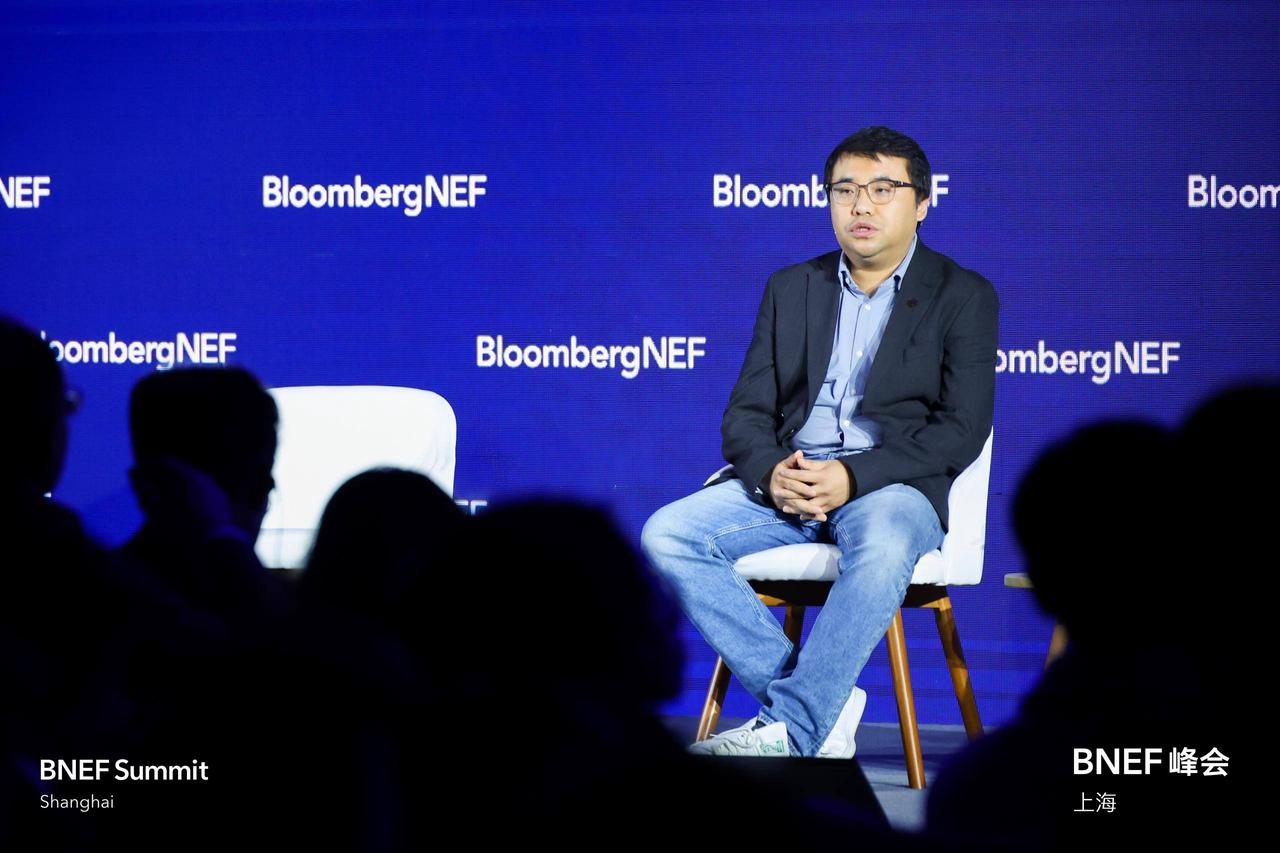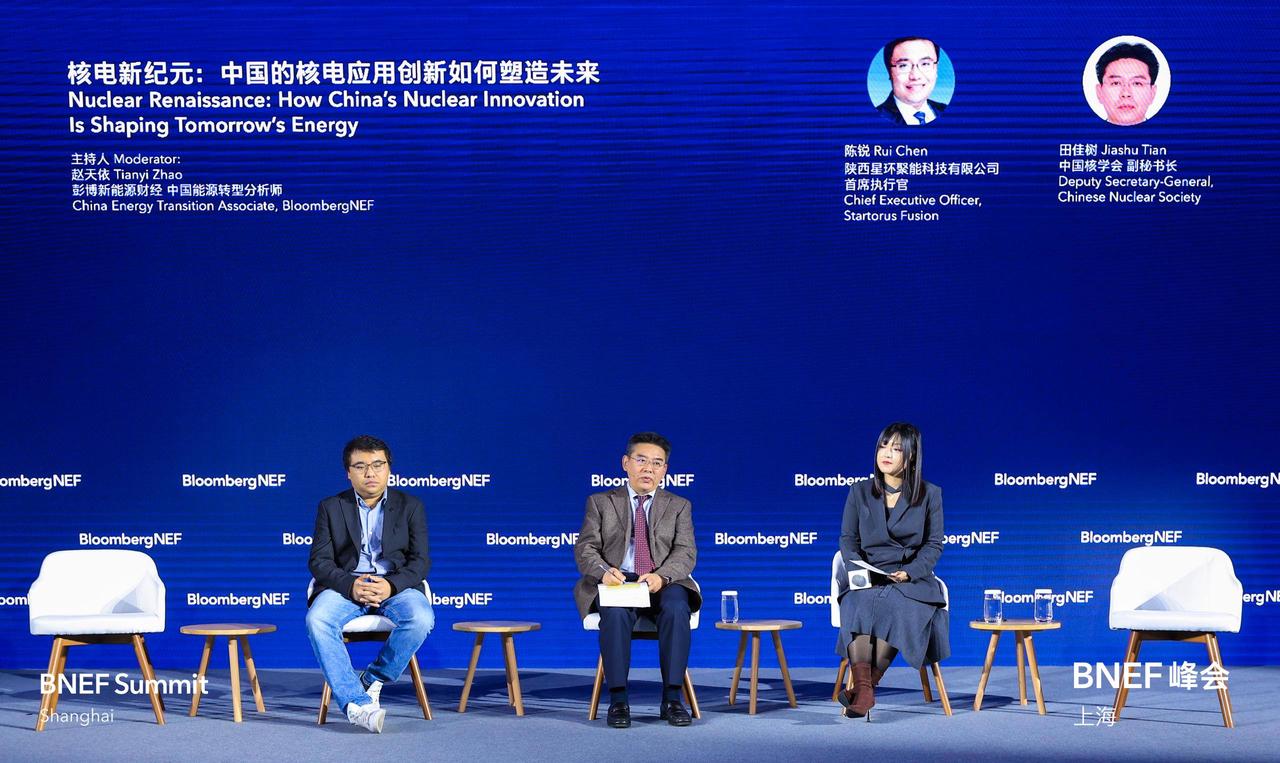The 2024 Bloomberg New Energy Finance Summit Shanghai (BNEF Summit Shanghai) brings together top experts, entrepreneurs and investors in the global energy field to discuss the future trends and development of new energy. Chen Rui, CEO of Startorus Fusion, was invited to attend and receive an on-site interview to express his views on the key role of fusion energy in global and China’s energy transformation and its commercialization prospects.
Chen Rui pointed out that fusion energy, with its clean, efficient, stable and safe characteristics, is regarded as the “ultimate energy” of mankind. Once commercialized, it will provide important support for China to achieve the goal of carbon neutrality and promote the optimization and upgrading of the global energy structure.
When talking about China’s leading edge in controllable nuclear fusion, Chen Rui said that with its strong strength in the fields of materials, machinery, electronics, electricity and IT, China is expected to make breakthroughs in the engineering realization of fusion technology. At the same time, China’s scientific research institutions and commercial companies have been actively promoting the development of fusion technology. It is believed that with the efforts of all parties, China is expected to become the first country to realize fusion power generation.
However, the commercialization of controlled nuclear fusion technology still faces many challenges. Chen Rui admitted that China needs to establish an independent regulatory system suitable for fusion technology and formulate corresponding regulatory policies to accelerate the commercialization of fusion technology.

On the spot, Chen Rui also analyzed the differences between commercial companies and the “national team” in the field of investment. He said that the advantages of commercial companies are quick decision-making, incentives for R&D personnel on point, radical technology routes, and higher returns. But at the same time, commercial companies also need to bear greater financial pressure. In contrast, the “national team” has abundant funds and can carry out long-term research and development more calmly. Therefore, commercial companies need to give full play to their own advantages and overcome the disadvantages of capital in order to achieve sustainable development.
Chen Rui is optimistic about the development prospects of the controlled fusion industry. “The world’s top companies are actively investing in research and development, with the goal of building fusion demonstration reactors by 2035”, he said, “no matter which company can successfully build a real fusion demonstration reactor, it will be a great progress in the field of fusion and human society”.
As one of the representatives of domestic commercial fusion enterprises, Startorus Fusion has been committed to promoting technological innovation and application. Chen Rui’s speech at the summit revealed the challenges and opportunities facing the commercialization of controllable nuclear fusion, and also showed the broad prospects for the development of fusion energy in China. We have reason to believe that controllable nuclear fusion technology will contribute to the energy transformation and carbon neutrality goals of China and even the world.
The following is a live interview with Bloomberg News
The interview content is edited as follows. If the translation is inaccurate, please refer to the video content.
Host: The first question is about Startorus Fusion, can you introduce the case of the company briefly with us?
Chen Rui: Well. Startorus Fusion is a Chinese commercial fusion company founded in 2021. We focus on the research and development and commercial application of fusion energy.
Host: I believe you have heard such a joke that controlled nuclear fusion is a technology always exists in the “future”, is “forever 50 years”, can you talk about the progress of fusion in China and the world, and the current situation of fusion commercialization in China?
Chen Rui: In the past five years, remarkable progress has been made in global fusion technology. For example, CFS (Commonwealth Fusion Systems) from MIT has successfully built 20T high temperature superconducting magnets and raised nearly $2 billion; NIF (National Ignition Facility) has also achieved a breakthrough in the energy output of fusion reactions greater than 1. In China, the East Superloop (EAST) has achieved kilosecond long pulse plasma operation with high parameters, and the circulation 3 has also reached the operation level of 1MA plasma current. These developments have promoted the development of fusion technology not only in China and the United States, but also in the world, and created favorable conditions for future industrialization and financing. Of course, I think China and the United States are the two major countries in this field. Over the past five years, the United States has raised $5 billion in this field, while China’s market-oriented investment has reached $500 million, ranking second.
Host: If you are asked to predict the future, when do you think the commercialization of fusion will be realized and when will it be able to supply power to the grid? Is it 10, 20 or 50 years?
Chen Rui: I personally hold a positive and optimistic attitude towards this. I think in the next 10 years, at least some commercial companies will be able to build fusion demonstration power plants. Of course, this is not a complete commercialization, but at least it can prove that we can use fusion reaction to generate electricity.
Host: Although you mentioned that fusion has begun to receive financial support, compared with solar energy and wind energy, which are more concerned by people, more favored by capital and achieve capacity building, fusion is still very niche. I want to know why you chose such a track which is extremely difficult in the field of energy?
Chen Rui: Fusion is chosen because it represents the ultimate problem that human beings have to face. Fusion has all the energy advantages you can think of: unlimited raw materials, greater safety and higher energy density. This is why fusion is widely regarded as the ultimate energy source for mankind. Although fusion technology is indeed very difficult, with the continuous progress of technology, especially the rapid development of high-temperature superconducting materials and AI, we are moving faster towards the goal of fusion.
Host: Let's talk about technical issues later. You mentioned earlier the contrast between commercial fusion companies and national projects. What are the advantages of the commercial route for fusion?
Chen Rui: It seems that every coin has two sides, with both advantages and disadvantages. First, for commercial fusion companies, taking our company as an example, we can make bolder scientific decisions and choose more radical technological routes, which of course means higher returns. Secondly, compared with the large amount of financial support for national projects, commercial companies are always relatively tight in terms of funds, but it also pushes us to keep fighting and trying to survive.
Host: So is attracting investment still a difficult problem?
Chen Rui: Although the situation has improved, attracting investment is still an important issue that we need to continue to face.
Host: Finally, you mentioned the application of AI, and I also learned about the progress of some new fusion materials. Which of these new technologies are you most interested in?
Chen Rui: I think the progress of two technologies is very important. The first is the high temperature superconducting magnet made of high temperature superconducting materials. CFS has demonstrated that it enables us to achieve higher magnetic fields in smaller sizes, thereby reducing costs and equipment construction time, so that we can achieve fusion quickly and economically. Secondly, AI technology has been published in the industry, explaining that AI can greatly improve our ability to control plasma. I think these two points are very important, and they will greatly promote the development of fusion technology.
Bloomberg New Energy Finance Summit Shanghai (BNEF Summit Shanghai) is one of a series of high-end energy summits organized by Bloomberg New Energy Finance (Bloomberg NEF). The summit plays an important role in promoting global energy transformation, promoting technological innovation and cooperation, and strengthening financial synergy and investment. With the increasing global attention to renewable energy, energy security, environmental protection and other issues, as well as China’s rapid development in the field of new energy and the proposal of the “double carbon” goal, Bloomberg New Energy Finance Summit Shanghai has become an important platform for global energy elites to talk about the future and explore development.





